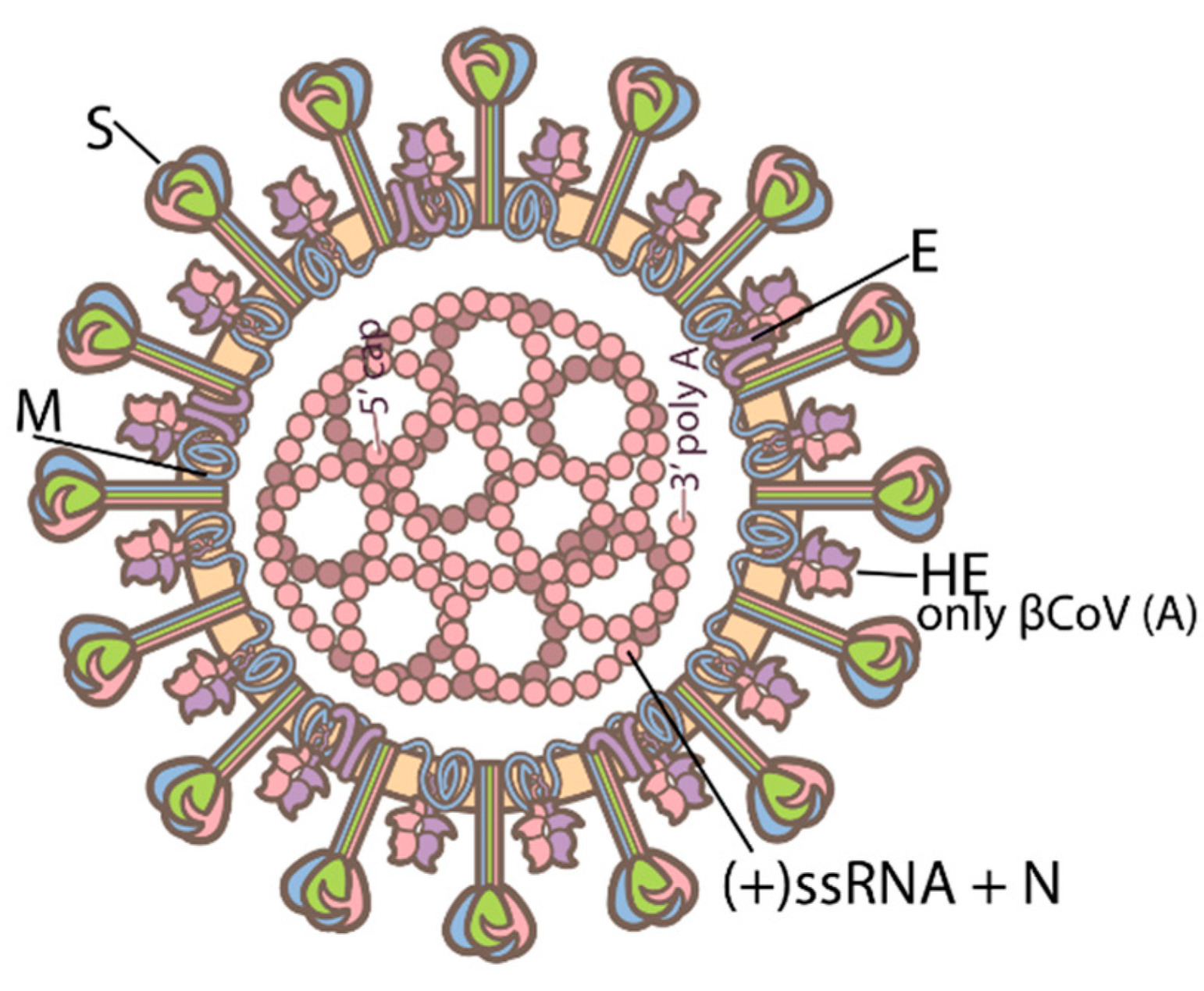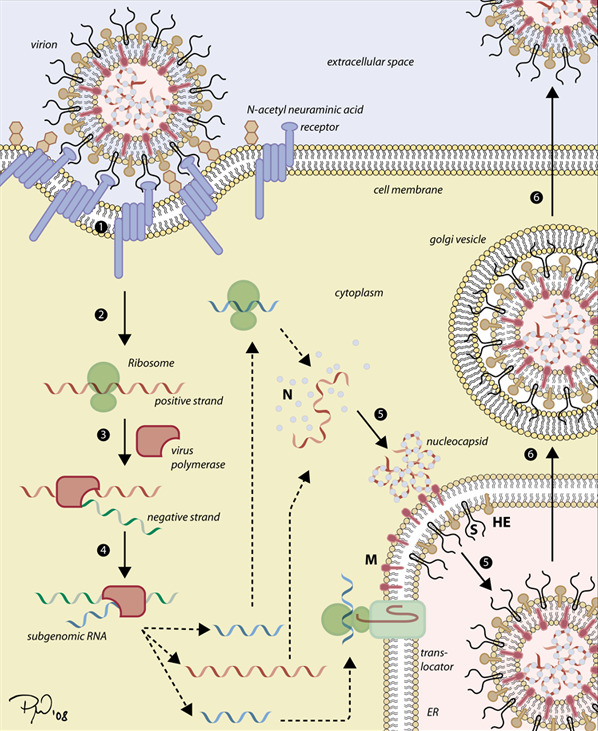Coronaviruses are a group of related viruses that contain positive-sense, single-stranded RNA. Coronavirus derives its name from "κορώνα" in Greek, which translates as “crown,” after the small club-shaped proteins Proteins Linear polypeptides that are synthesized on ribosomes and may be further modified, crosslinked, cleaved, or assembled into complex proteins with several subunits. The specific sequence of amino acids determines the shape the polypeptide will take, during protein folding, and the function of the protein. Energy Homeostasis visible as a ring around the viral envelope Envelope Bilayer lipid membrane acquired by viral particles during viral morphogenesis. Although the lipids of the viral envelope are host derived, various virus-encoded integral membrane proteins, i.e. Viral envelope proteins are incorporated there. Virology in electron micrographs. Coronaviruses have large genomes, a propensity for mutation Mutation Genetic mutations are errors in DNA that can cause protein misfolding and dysfunction. There are various types of mutations, including chromosomal, point, frameshift, and expansion mutations. Types of Mutations, and frequent recombination Recombination Production of new arrangements of DNA by various mechanisms such as assortment and segregation, crossing over; gene conversion; genetic transformation; genetic conjugation; genetic transduction; or mixed infection of viruses. Virology events that have resulted in a diversity of species. These new species are capable of rapid adaptation to new hosts and ecologic environments, making them very hardy and difficult to combat. New coronavirus infections Infections Invasion of the host organism by microorganisms or their toxins or by parasites that can cause pathological conditions or diseases. Chronic Granulomatous Disease have appeared in both humans and animals Animals Unicellular or multicellular, heterotrophic organisms, that have sensation and the power of voluntary movement. Under the older five kingdom paradigm, animalia was one of the kingdoms. Under the modern three domain model, animalia represents one of the many groups in the domain eukaryota. Cell Types: Eukaryotic versus Prokaryotic. Coronaviruses are known to be the cause of some cases of the common cold Common cold A catarrhal disorder of the upper respiratory tract, which may be viral or a mixed infection. It generally involves a runny nose, nasal congestion, and sneezing. Rhinovirus, severe acute respiratory syndrome (SARS), Middle East respiratory syndrome (MERS), and coronavirus disease 2019 Coronavirus disease 2019 Coronavirus disease 2019 (COVID-19) is an infectious disease caused by the severe acute respiratory syndrome coronavirus 2 (SARS-CoV-2) that mainly affects the respiratory system but can also cause damage to other body systems (cardiovascular, gastrointestinal, renal, and central nervous systems). ( COVID-19 COVID-19 Coronavirus disease 2019 (COVID-19) is an infectious disease caused by the severe acute respiratory syndrome coronavirus 2 (SARS-CoV-2) that mainly affects the respiratory system but can also cause damage to other body systems (cardiovascular, gastrointestinal, renal, and central nervous systems). ).
Last updated: Jul 9, 2023

RNA virus identification:
Viruses can be classified in many ways. Most viruses, however, will have a genome formed by either DNA or RNA. RNA genome viruses can be further characterized by either a single- or double-stranded RNA. “Enveloped” viruses are covered by a thin coat of cell membrane (usually taken from the host cell). If the coat is absent, the viruses are called “naked” viruses. Viruses with single-stranded genomes are “positive-sense” viruses if the genome is directly employed as messenger RNA (mRNA), which is translated into proteins. “Negative-sense,” single-stranded viruses employ RNA dependent RNA polymerase, a viral enzyme, to transcribe their genome into messenger RNA.

Envelope proteins are denoted:
S: spike
HE: hemagglutinin esterase
M: membrane
E: envelope
N: nucleocapsid
(+)ssRNA: positive-sense single-stranded RNA
Most coronaviruses have 4 structural proteins Structural proteins Proteins and Peptides: S, E, M, and N.

Replication cycle of coronaviruses:
1. Coronaviruses bind to the host cell surface via the S proteins. Viral entry occurs either by receptor-mediated endocytosis or through membrane fusion. The virus escapes the acidified environment of the endosomes by transporting itself to lysosomes.
2. Coronaviruses have single-stranded, positive-sense RNA that can directly produce the proteins and new genomes in the cytoplasm.
3. The negative-sense strand template RNA is produced.
4. The new viral proteins are translated by the host’s ribosomes.
5. The nucleocapsid protein binds with genomic RNA, and protein M is integrated into the membrane of the endoplasmic reticulum (ER) along with proteins S and HE.
6. Assembled nucleocapsid that contains the RNA moves into the ER to be encased and is released by exocytosis.
| MERS-CoV | SARS-CoV | SARS-CoV-2 | |
|---|---|---|---|
| Date of first identified case | June 2012 | November 2002 | December 2019 |
| Location of first identified case | Jeddah, Saudi Arabia | Shunde, China | Wuhan, China |
| Average age | 56 years | 44 years | 56 years |
| Sex Sex The totality of characteristics of reproductive structure, functions, phenotype, and genotype, differentiating the male from the female organism. Gender Dysphoria ratio (M:F) | 3.3:1 | 0.8:1 | 1.6:1 |
| MERS (caused by MERS-CoV) | SARS (caused by SARS-CoV) | COVID-19 COVID-19 Coronavirus disease 2019 (COVID-19) is an infectious disease caused by the severe acute respiratory syndrome coronavirus 2 (SARS-CoV-2) that mainly affects the respiratory system but can also cause damage to other body systems (cardiovascular, gastrointestinal, renal, and central nervous systems). (caused by SARS-CoV-2) | |
|---|---|---|---|
| Fever Fever Fever is defined as a measured body temperature of at least 38°C (100.4°F). Fever is caused by circulating endogenous and/or exogenous pyrogens that increase levels of prostaglandin E2 in the hypothalamus. Fever is commonly associated with chills, rigors, sweating, and flushing of the skin. Fever | 98% | 99%–100% | 87.9% |
| Dry cough Dry Cough Strongyloidiasis | 47% | 29%–75% | 67.7% |
| Dyspnea Dyspnea Dyspnea is the subjective sensation of breathing discomfort. Dyspnea is a normal manifestation of heavy physical or psychological exertion, but also may be caused by underlying conditions (both pulmonary and extrapulmonary). Dyspnea | 72% | 40%–42% | 18.6% |
| Diarrhea Diarrhea Diarrhea is defined as ≥ 3 watery or loose stools in a 24-hour period. There are a multitude of etiologies, which can be classified based on the underlying mechanism of disease. The duration of symptoms (acute or chronic) and characteristics of the stools (e.g., watery, bloody, steatorrheic, mucoid) can help guide further diagnostic evaluation. Diarrhea | 26% | 20%–25% | 3.7% |
| Sore throat Sore throat Pharyngitis is an inflammation of the back of the throat (pharynx). Pharyngitis is usually caused by an upper respiratory tract infection, which is viral in most cases. It typically results in a sore throat and fever. Other symptoms may include a runny nose, cough, headache, and hoarseness. Pharyngitis | 21% | 13%–25% | 13.9% |
| Ventilator use | 24.5% | 14%–20% | 4.1% |
| Organism | SARS-CoV-2 | Rhinovirus Rhinovirus Rhinovirus is an acid-labile, positive-sense RNA virus of the Picornavirus family. The virus, which causes the common cold, is most often acquired through the airway via the inhalation of aerosols containing rhinovirus and fomites. Rhinovirus | Coxsackievirus Coxsackievirus Coxsackievirus is a member of a family of viruses called Picornaviridae and the genus Enterovirus. Coxsackieviruses are single-stranded, positive-sense RNA viruses, and are divided into coxsackie group A and B viruses. Both groups of viruses cause upper respiratory infections, rashes, aseptic meningitis, or encephalitis. Coxsackievirus |
|---|---|---|---|
| Characteristics |
|
|
|
| Transmission |
|
|
|
| Clinical |
|
|
|
| Diagnosis |
|
Clinical diagnosis | Clinical diagnosis |
| Management |
|
|
|
| Prevention |
|
|
|